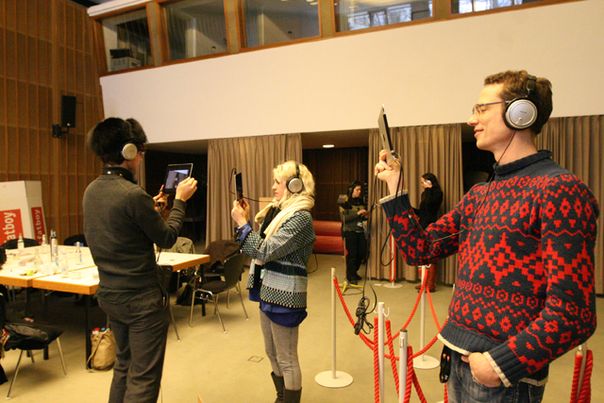Cognitive interactivity beyond physical interaction
Navigation and storytelling come together in a Campus workshop that aims to unsettle our perception of space through clever use of narrative and new media.

A moment from the “Multiplayer Video Walks” workshop
Live performance and new media may seem like disparate disciplines, but they have something in common: both have vast potential for engaging the audience in an interactive way. Rimini Protokoll, a group of theatre artists based in Berlin (Helgard Haug, Stefan Kaegi and Daniel Wetzel), have been exploring that potential in their work, which often deals with site-specific and/or sociological and demographic issues. Participants had a chance to explore their approach, as well as some of the technical protocols they employ, at the Campus‘ “Multiplayer Video Walks” workshop.
In “Call Cutta in a Box” (2008), members of the audience were guided through Berlin using headphones, via directions given from a call centre in Calcutta, India, by people who had never been to Berlin. At the Campus workshop, the group explored a technical protocol enabling another kind of directed navigation through space. Using iPads, each of the participants produced a 5-minute video designed to guide others through a specific space, using voice instructions or storytelling. Those being guided were then able to reconcile and contrast the pre-recorded video and voice instructions with live reality.
The technical protocol presented at the workshop playfully inverts the process of documenting reality: the video material here is simultaneously the document of one person’s route and a script for another person who will later re-enact the route, following it on video. This enables a simultaneously uncanny and amusing interplay between the different temporalities of the pre-recorded video and the live re-enactment, as well as between the identities of those conceiving and recording the route, and those following it. That interplay mimics the way we identify with fictional characters and takes it to its radical consequence: It puts the participants into the shoes of the person who has made the video, and also exposes the gaps between the viewpoints of those two individuals.
But more than anything, this interplay between video and live re-enactment expands the potential of fiction and the degree of imagination the audience invests in the unfolding of the events. The fact that the spectator is navigating through some concrete physical reality, while he or she is presented with a similar yet different narration on the pre-recorded video (a fiction), enables active audience participation that goes beyond mere interactivity in terms of physical movement through space. The real site of interactivity lies in the gap between two distinct points of view – that of the video-maker and that of the viewer/participant, a gap that might function as a catalyst for a creative dialogue between two temporally and personally distinct points of view.


301 Moved Permanently